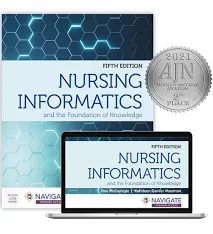The Impact of Nursing Informatics on Patient Outcomes and Patient Care Efficiencies Sample
Health care is one of the many sectors that have registered massive advancements in technology use and integration into practice. Given the numerous challenges, the sector must contend with, establishing quick and lasting solutions is imperative. Nursing informatics plays a significant role in improving patient outcomes and care efficiencies. When discussing nursing informatics, the discussion is often about technology. The definition by Saheb and Saheb (2019) includes a field of nursing that incorporates nursing science, technology and informational sciences to develop, process, and manage data.
The significance of information in health care is unparalleled, primarily because it enables nurses to observe patients’ safety, access patients’ history and obtain a patient’s complete clinical picture (Saheb & Saheb, 2019). Among the technologies of crucial significance in nursing, informatics include electronic health (EHR) records and artificial intelligence (AI). This paper aims to describe a nursing informatics project, identify stakeholders affected and explain how the project impacts patient outcomes. Further, technologies leveraged and the roles of each of the project team members are highlighted.
Description of the Project

Due to identified gaps in patient care, particularly patient’s safety, this paper proposes a project proposal that incorporates both EHR and AI to solve the problem. The healthcare facility chosen specializes in critical care, especially trauma cases and advanced cardiovascular life support. These patients require close monitoring and care to avoid deterioration of their health status. The project involves the use of an EHR at the casualty department to enter details of critically ill patients. Special computer software then filters the information and performs computer-directed triaging. The system then automatically communicates to the emergency ward.
The emergency room nurses receive the communication via mobile phones and act quickly. The project aims at eliminating delays during triaging, and the death of acutely or severely ill patients. In reference to Stone (2019), due to poor triaging techniques, acutely injured patients die while doctors attend to those with minor injuries. This realization drives the need for a better triaging technique, as proposed in this project.
The project also incorporates the use of artificial intelligence. This part involves the use of a smart algorithm embedded within an EHR. Data is entered into the algorithm, which produces a scoring system based on how ill the patient is. The system determines acutely ill patients that require urgent care, and identifies patients with significant improvement, as well as those who need to be transferred to other wards for special care. When the scoring system indicates patient deterioration, nurses receive alerts via their mobile phones.
Numerous researchers have previously assessed the efficacy of similar technologies with promising results. For example, the Rothman index, which is a scoring system, has been used to identify patients at risk and with urgent need of care (Robert, 2019). This project, therefore, borrows largely from past tested evidence-based literature concerning the use of artificial intelligence in health care to improve patient’s outcomes in emergency departments.
Stakeholders
Various individuals or organizations can be actively involved or have an interest in a project. Further, the project implementation process can have both negative and positive effects on patients and nurses, hence the need for close monitoring. In this project, the first stakeholders are the medical leaders. From the topmost rank is the health care facility administrator, who is responsible for the daily operations within the hospital and coordinates the functions of all the departments, including the emergency unit. The administrator must be aware of any project happening within the facility. This